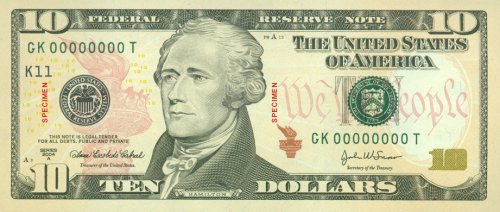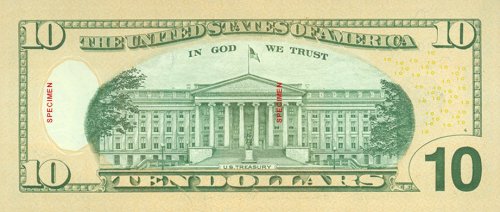New $10 bill

Washington - (December 2, 2005) - Redesigned Series 2004 $10 notes will be issued beginning on March 2, the U.S. Department of the Treasury and Federal Reserve Board announced today. On this day of issue, Federal Reserve banks will begin distributing the new notes to the public through commercial banks.
The notes will begin circulating immediately in the United States, and then be introduced in other countries in the days and weeks following, as international banks place orders for $10 notes from the Federal Reserve.
Today’s announcement is a signal to businesses that handle cash and use machines that receive or dispense cash, to make final preparations for the new notes. For some businesses, getting ready for the new $10 note means training cash-handling employees on how to use the notes’ updated security features; for others, the change involves making technical adjustments to machines that receive or dispense cash, such as vending and self-checkout machines.
In order to stay ahead of counterfeiters, the U.S. government will redesign the currency every seven to ten years.
As part of its education program aimed at preparing the public for the new $10 note, the Bureau of Engraving and Printing (BEP) has put special emphasis on regular communication with manufacturers of cash-handling machines and their customers, to ensure they have the information they need and ample time to adjust their equipment to receive and dispense the new notes.
Highlighted by images of the Statue of Liberty’s torch and the words “We the People” from the U.S. Constitution, the new $10 note incorporates easy-to-use security features for people to check their money and subtle background colors in shades of orange, yellow and red.

“As always, you don’t have to trade in your old $10 notes for new ones. Both new notes and old notes maintain their full face value,” said Federal Reserve Board Assistant Director of Reserve Bank Operations and Payment Systems Michael Lambert. “The updated security features in this redesigned $10 note ensure that it will continue to remain a source of value, trust and confidence around the world.”
The new $10 note - like the redesigned $20 and $50 that preceded it - incorporates state-of-the-art security features to combat counterfeiting, including three that are easy to use by cash handlers and consumers alike:
- Color-shifting ink: Tilt your ten to check that the numeral “10” in the lower right-hand corner on the face of the note changes color from copper to green.
- Watermark: Hold the note up to the light to see if a faint image of Treasury Secretary Alexander Hamilton appears to the right of his large portrait. It should be visible from both sides of the note. On the redesigned $10 note, it is easier than ever to locate the watermark - a blank oval has been incorporated into the design to highlight the watermark’s location.
- Security thread: Hold the note up to the light and make sure there’s a small strip that repeats “USA TEN” in tiny print. It should run vertically to the right of the portrait.
“We expect to update currency every seven to ten years in order to stay ahead of the latest digital technology available to would-be counterfeiters,” said BEP Director Tom Ferguson. “Each time we introduce a redesigned note into circulation, our objective is its seamless transition into daily commerce, both in the United States and around the world.”
Counterfeiting of U.S. currency has been kept at low levels through a combination of improvements in security features, aggressive law enforcement and education efforts to inform the public about how to check their currency.
Because the improved security features are more effective if the public knows about them, the U.S. government has been undertaking a broad, worldwide public education program that seeks to raise awareness of the changes to U.S. currency and educate financial institutions, cash handlers and the general public about those improvements.
An array of free educational materials, posters, handy “take one” cards, training videos and CD-ROMs are available to businesses, financial institutions, trade and professional associations, citizen groups and individuals to prepare cash handlers and consumers to recognize the new design and protect against counterfeits. Materials are available to order or download on-line at www.moneyfactory.gov/newmoney.
Since the BEP began taking orders for educational materials describing changes to the Series 2004 currency in May 2003, about 70 million pieces of training materials have been ordered by businesses and other organizations to help them train their cash-handling employees about the notes’ enhanced security features.
The new $10 note is the latest in the new series of U.S. currency. The new series began with the $20 note in 2003 and continued with the $50 note in 2004. The $100 note will be the next denomination to be redesigned after the $10 note. At this time, the government has no plans to redesign the $5 note, and the $1 and $2 notes will not be redesigned.
(via monefactory.gov)